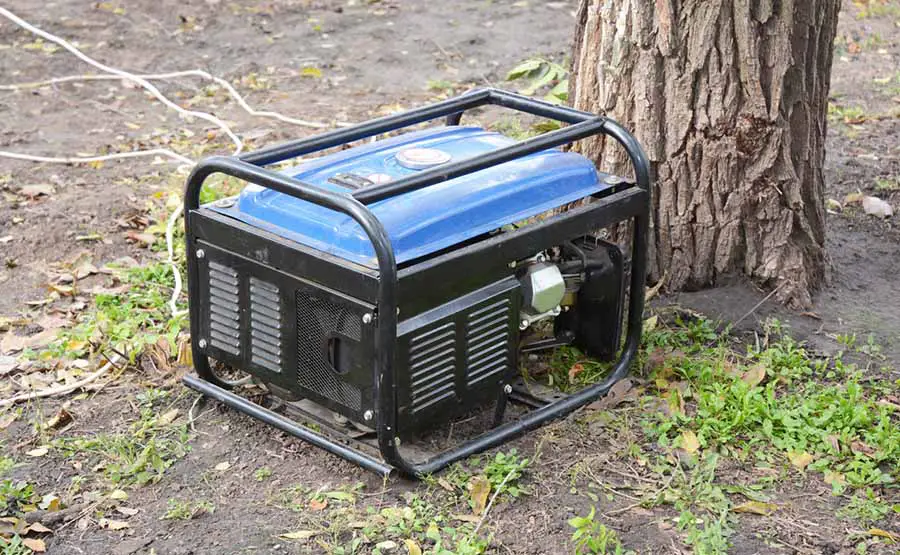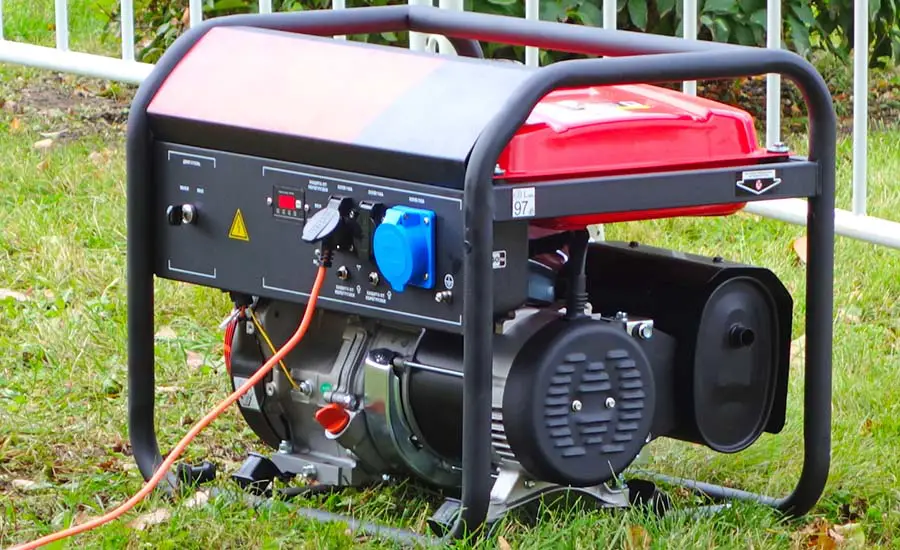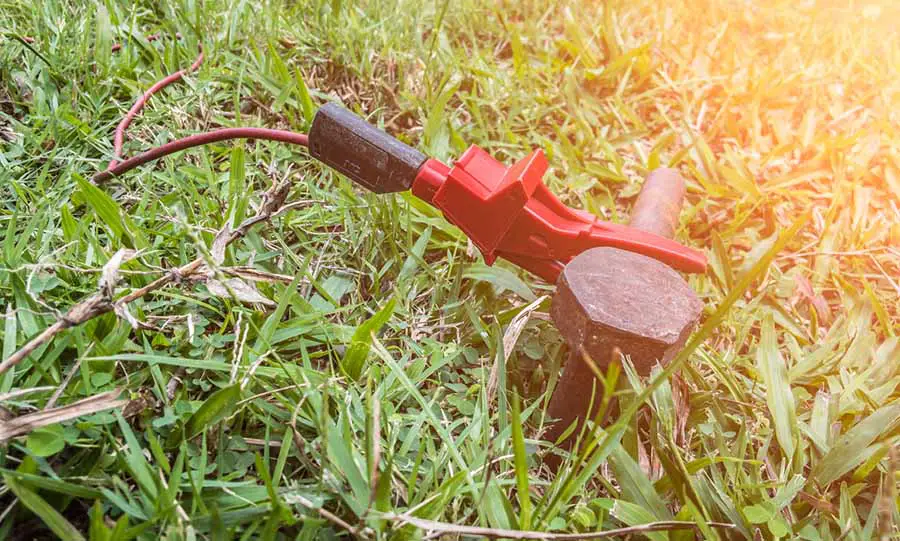
You must adequately ground generators to the earth. It is as simple as that. Electricity will always take the path of least resistance to the ground, and if that path is through you or your appliances, then you are in for a distressingly shocking experience.
Electricity follows the path of least resistance, so grounding your generator will help prevent minor electrical shocks and electrocution in a worst-case scenario. Failure to ground a generator without built-in grounding vis the metal frame is hazardous and puts you at risk of electrocution.
Let us have a look at just what happens if you do not ground your generator, and then we’ll investigate ways to prevent the worst from happening.
Portable Generator and Grounding Basics
A generator is quite simply a stand-alone device that uses the mechanical energy from an internal combustion engine powered by various forms of fuel, including diesel, gasoline, and liquid petroleum gas (LPG). It moves the electrical charges created within the generators’ internal wiring system through to, and then out of, the electrical outlet ports of the unit.
This electrical current passes through the hot (or positive) wire to the appliance you are powering and then completes the circuit to the generator through the neutral (or negative) wire.
The third wire in the system is called the grounding wire or the earthing wire. It is not part of the electrical circuit in that it does not carry an electrical current. It is merely a safety mechanism.
This ground wire will offer any fault current a path of low resistance back to the source rather than sending the current through any metal parts attached to the electrical circuit, such as the generator itself or the metal body of your toaster.
Grounding, or earthing, is a safety measure devised to prevent people from being shocked by their electrical appliances and systems. The process involves transferring the discharge of electrical energy into the earth utilizing a low resistance wire or, in the case of most portable generators, via the frame.
What Happens If You Do Not Ground Your Generator?

Grounding, or earthing, a portable generator is quite simply a method of lessening the chance of electrocution by offering an alternative electrical current path – other than yourself – if any errant electrical current finds itself flowing where it should not flow.
Electrical currents will always find the path of least resistance to the ground. For example, lightning will always hit a metal pole or a tree first instead of striking the ground. The very same electrical process occurs when there is an arc flash from your portable generator.
If your generator is not grounded, the discharge from this arc may find, to your great discomposure, that the path of least resistance is through your body. It should be unnecessary to point out that this can be an extremely troublesome experience and, in the worst-case scenario, may even result in death.
A power surge may irreparably damage the appliances that you have plugged into your generator. If your portable generator is not grounded correctly, your appliances are particularly vulnerable to any power surges when plugged into the system. This can even happen when you are merely switching them on and off.
Power surges or voltage spikes will overload the wiring of your appliances, causing them to overheat and damaging their internal components or, worse, cause an electrical fire.
Last but not least, because electrical codes require that separately derived systems be grounded, it is a codified safety requirement. Suppose you decide (for some reason known only to yourself) not to ground the generator despite the applicable electrical codes properly. In that case, you will be running foul of legally enforceable regulations.
Sitting on the naughty step while the authorities dangle a fine over your head is a distinct possibility and one that is entirely avoidable if you take the simple steps to ground your portable generator.
The Occupational Safety and Health Administration (the OSHA) have stated the following and issued the codes mentioned about the grounding requirements for portable generators:
“Under the following conditions, OSHA directs (29 CFR 1926.404(f)(3)(i)) that the frame of a portable generator need not be grounded (connected to earth) and that the frame may serve as the ground (in place of the earth):
– The generator supplies only equipment mounted on the generator and/or cord and plug-connected equipment through receptacles mounted on the generator, § 1926.404(f)(3)(i)(A), and
– The non current-carrying metal parts of equipment (such as the fuel tank, the internal combustion engine, and the generator’s housing) are bonded to the generator frame, and the equipment grounding conductor terminals (of the power receptacles that are a part of [mounted on] the generator) are bonded to the generator frame, § 1926.404(f)(3)(i)(B).
Thus, rather than connect to a grounding electrode system, such as a driven ground rod, the generator’s frame replaces the grounding electrode.”
However, if you possess a separately derived system, they go on to say this:
“If these conditions do not exist, then a grounding electrode, such as a ground rod, is required.
If the portable generator is providing electric power to a structure by connection via a transfer switch to a structure (home, office, shop, trailer, or similar) it must be connected to a grounding electrode system, such as a driven ground rod.
The transfer switch must be approved for use and installed in accordance with the manufacturer’s installation instructions by a qualified electrician.
Grounding requirements for generators connected via transfer switches are covered by Article 250 of the National Electrical Code (NEC).”
Mike Holt has lectured extensively concerning the National Electrical Code [2450.4, 2020 NEC], and it would be worth your while to check out one of his seminars:
Before we go into how to ground your generator safely, it is always a good idea to take note of the safety requirements laid out by the OSHA. This is very good advice, and we would encourage you to follow these suggestions to the letter:
- “Maintain and operate portable generators in accordance with the manufacturer’s use and safety instructions.
- Never attach a portable generator directly to the electrical system of a structure (home, office, or trailer) unless the generator has a properly installed open-transition transfer switch.
- Always plug electrical appliances and tools directly into the generator, using the appliance manufacturers supplied cords. Use heavy-duty extension cords that contain a grounding conductor (3-wire flexible cord and 3-pronged cord connectors).
- Proper grounding and bonding are a means to prevent shocks and electrocutions.
- Use ground-fault circuit interrupters (GFCIs) as per the manufacturer’s instructions.
- Do not connect a generator to a structure unless the generator has a properly installed transfer switch.
- Visually inspect the equipment before use; remove defective equipment from service; mark or tag it as unsafe for use.”
Do You Need to Ground Your Portable Generator?
Yes, it does. The only question is whether your generator has built-in grounding via the frame or whether it is not grounded at all. Fortunately, most generators manufactured these days are a single unit, and they will incorporate the grounding mechanism into the metal frame around the motor.
This frame will act as the path of least electrical resistance, ensuring that the current reaches the ground using the frame acting as the grounding mechanism. These are called non-separately derived systems.
The instruction manual that came with your generator will let you know whether you have a non-separately derived system or not. If you own one of these types of generators, you can use it without worrying about any dangerous electrical discharge emanating from it while in use. The likelihood is that your generator will fall into this category as most portable generators manufactured these days are non-separately derived systems.
However, suppose you ascertain that your unit cannot ground itself via the frame after reading the manual. In that case, you should take steps to ensure that it is appropriately “earthed” before using it for any purpose at all.
Suppose you have somehow mislaid the user manual for your generator and want to know if you must ground your unit. In that case, the easiest way to check if you will need to ground it yourself is to scrutinize your generator’s transfer switch to see if it has the option to transfer current to a neutral ground conductor. The transfer switch is an electrical device that moves your home’s internal electrical circuit to your portable generator from the primary power grid.
If this is the case, then the components of your generator will consist of a separately derived system. In this instance, you will have to ensure that you ground your generator with a separate grounding system.
It may be helpful to you to understand the safety fundamentals of grounding an electrical current.
How to Ground a Portable Generator

Grounding your generator can be a very simple operation that will require only a few tools and a bare minimum of equipment. This is what you will need:
- A Copper Grounding Rod – An electrical copper grounding rod is designed to be driven firmly into any piece of ground into which an errant electrical current can be safely exhausted and dissipated. Buy a grounding rod that is at least four or five feet in length. However, we would recommend an eight-foot rod for permanent home installations. Four feet is probably enough for most portable generators.
- Copper Grounding Wire – You will use the copper grounding wire to connect your generator to your copper grounding rod. Purchase enough copper wire to reach the grounding rod that you have driven into the earth. Ten to fifteen feet would usually be sufficient.
- Wire Strippers, Wrench, and Pliers – You will need the wire strippers to strip the copper grounding wire and the pliers to wind it onto the copper grounding rod and the generator’s grounding bolt. You will use the wrench to loosen the grounding bolt attached to your portable generator.
- A Mallet – You will need a good heavy mallet to drive the copper grounding rod firmly into the ground. You may also require a shovel and a builders spike for rocky ground or particularly compacted ground. If the terrain is too hard to drive the rod straight into the ground, it should be fine to hammer it in at a 45-degree angle.
Always try to use the correct tools for the job, and we will always recommend that you purchase quality, well-built tools which should last for a few decades rather than just a few uses.
Once you have acquired all the tools and ordinances for the job, this is what you should do to ensure that your system is properly grounded. You can then go on to use your generator safe in the knowledge that you, your expensive electrical generator, and all the equipment you have hooked up to it are safe from electrocution or shock:
Firstly, make sure that your generator is turned to “off” before doing, or attempting to do, any of the following.
1. Drive Your Copper Grounding Rod Into the Ground
We would suggest driving the entire length into the ground to minimize the likelihood of electrocution. A depth of four (minimum) to eight feet negates the possibility that electrical discharge from the grounding rod may electrocute people standing nearby. This also ensures that the grounding rod is less likely to trip anyone up.
2. Wind the Copper Grounding Wire Onto the Grounding Rod
Using your wire strippers, expose a copper wire length of 6 to 12 inches off one end of the copper grounding wire. Then, using your pliers, connect the wire to the top of the grounding rod by winding it tightly and securely around the rod. You may also secure the copper wire by wrapping the exposed parts with insulation tape or, even more securely, with a clamp.
3. Connect the Copper Grounding Wire to Your Generator
Loosen the grounding bolt on your generator using your wrench or a correctly sized spanner. Strip about three inches off the other end of the copper grounding wire with the wire strippers and, using your pliers, tightly wrap the exposed copper wire around the grounding bolt of your generator. Re-tighten the nut with the wrench to ensure everything remains securely in place.
With some provisos (such as the length of the copper grounding rod), the following video helps illustrate the procedure:
You can now go ahead and use your generator to power up anything you wish, safe and secure in the knowledge that it is now correctly grounded.
Final Thoughts
Owning a generator gives you the peace of mind that you are covered if the power grid fails or you need a reliable source of electricity in a remote location. Ensuring that your generator is grounded correctly will ensure that the current keeps on flowing when you need it most and, more importantly, will not fry you or your precious -and expensive – electrical appliances.
